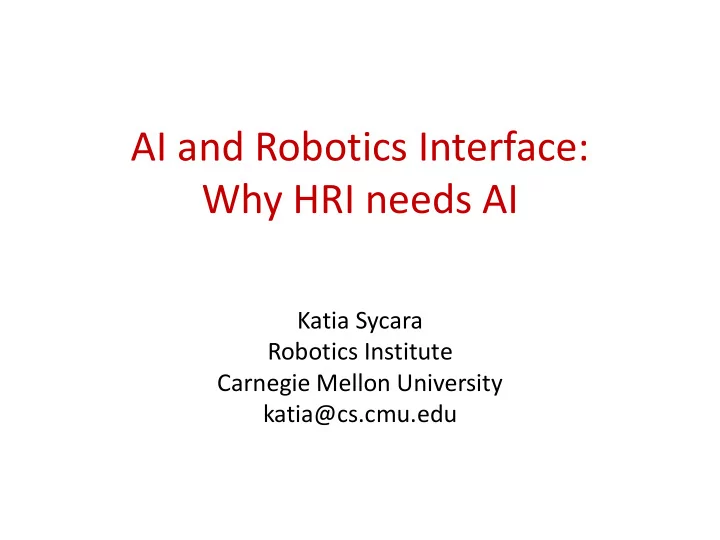

AI and Robotics Interface: Why HRI needs AI Katia Sycara Robotics Institute Carnegie Mellon University katia@cs.cmu.edu
Why Now? • Robotic Platforms have improved - robustness • Commercially available and relatively cheap • Advances in Vision and Speech Understanding • Vastly increased computational power • Networked Capabilities Result: time to revisit use of AI techniques in Robotics – Increase autonomous operation of robots – Robots interacting with humans (work, home, play) – Robots in society Katia Sycara -AI and Robotics 2
Issues in HRI • Imparting and recognizing intent from human to robot and vice versa • Establishing and maintaining “common ground” • Effective co-planning, human robot teaming • Dealing with failures • Life long learning Katia Sycara -AI and Robotics 3
Imparting and Recognizing Intent, Plans and Behavior • Necessary for any complex human in the loop autonomous robotic system • Two way street – especially challenging in multi-robot systems (AI has dealt with those) – Robot recognizes human intent – Human recognizes robot intent and behavior – Plan recognition and monitoring – Failure detection and repair – Robot generates explanations of behavior Katia Sycara -AI and Robotics 4
Problems of common ground: Perception/ common referents What a human sees What the robot sees A man with a walker relatively close An obstacle at distance of 183 cm at 15⁰ to observer Open Problems - Signal to symbol mapping -Representing context Katia Sycara -AI and Robotics 5
Characteristics of Robot Assistance and Teaming • Unobtrusiveness: the robot should assist the human without becoming a nuisance • Timeliness: the robot will not introduce delays to human or to itself • Non-interruption: robot will not interrupt human inappropriately • Safety : the robot should mind human’s and its own safety • Predictability : human should be able to interpret and predict robot’s actions; robot should be able to recognize and predict humans actions • Fluency: the robot should assist/interact with human for appropriate tasks at appropriate time • Proactivity: the robot should perform appropriate assistive actions without having been asked • Goal achievement: robot should know when the human-robot system has achieved the goal • Robustness/failure recovery: the robot should be able to gracefully recover from failure and perform repairs in a way that preserves interaction coherence -Need for formalization and computational modeling of the above characteristics, -Need for performance metrics These are components of trusted interaction Katia Sycara -AI and Robotics 6
AIR Issues in Human Robot Collaboration • Representation: – Need representations that span high level tasks to low level robotic motions, semantic representation of the environment (function, physical qualities etc) – Discrete to continuous – Signal to Symbol (eg semantic labeling of images) – Abstraction levels – Represent human actions, human and robot capabilities so that good functional allocation can be done or emerge • Inference – Computational tractability of symbolic representation schemes (dimensionality of space of potential robot actions even larger) – Scalable algorithms for reasoning about uncertainty and dynamism – Recognizing and dealing with failure – Common sense reasoning Katia Sycara -AI and Robotics 7
AI-R Issues in Human Robot Collaboration • Learning from experience – What experiences to collect and how, so they are reusable across different contexts – Representation, storage, indexing, retrieval of past experiences – Data mining not enough- need for semantics, data to knowledge – Experiences with high level tasks should be coherent with low level robot planning – Lifelong Learning – Learning from Failure Katia Sycara -AI and Robotics 8
Steps towards addressing the issues • Some good progress has been made in combinations of logical and probabilistic representations (e.g. probabilistic HTNs) • Progress in hybrid systems, verification techniques extending to MAS • Web accessible ontologies and representation schemes for high level task knowledge and low level motion planning, path planning etc • Human-based computation to provide data for learning by demonstration • Computational intractability for complex tasks will not go away: hence discover and exploit structure of different tasks and devise good approximation algorithms Katia Sycara -AI and Robotics 9
Science and Engineering • Science-Simplifying assumptions so that formal models can be constructed • Engineering-heuristics, dealing with complexity, integration of components How to best synergize these? Katia Sycara -AI and Robotics 10
• Questions? Katia Sycara -AI and Robotics 11
Recommend
More recommend